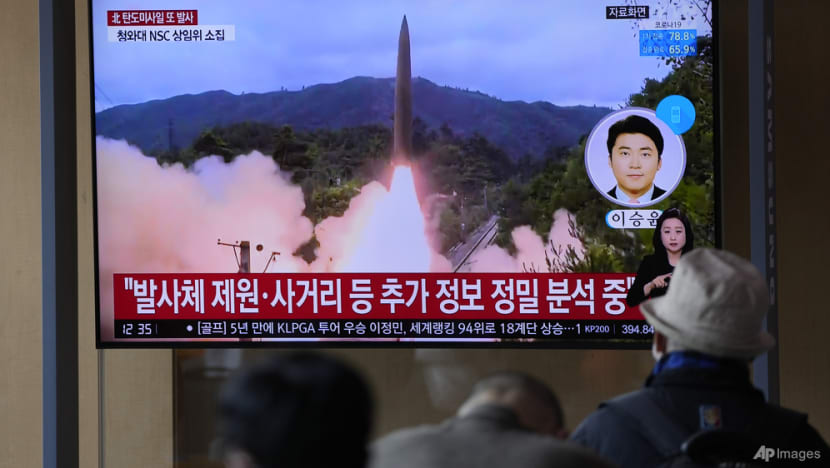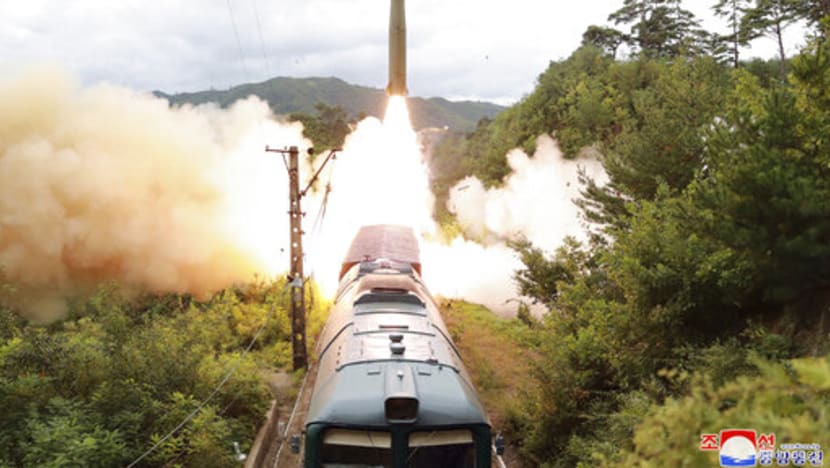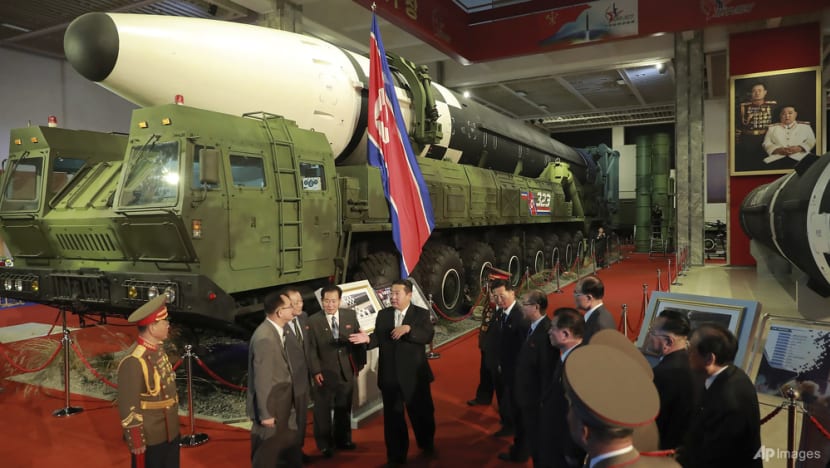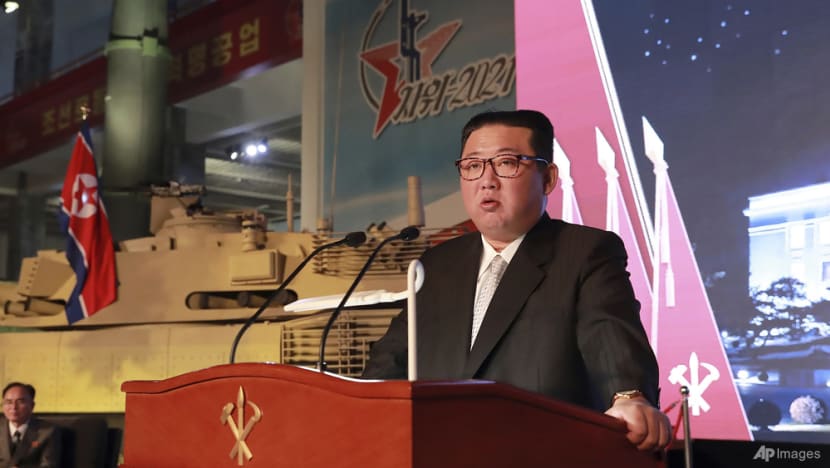How Kim Jong Un keeps advancing his nuclear programme

People watch a TV screen showing a news programme reporting about North Korea's missile launch with file footage at a train station in Seoul, South Korea, Oct 19, 2021. (Photo: AP/Lee Jin-man)
North Korean leader Kim Jong Un has shown no interest in resuming talks with the US after agreeing in 2018 to work towards “complete denuclearisation of the Korean Peninsula”.
Instead, he has been busy making his nuclear-equipped arsenal bigger, deadlier and better able to strike South Korea, Japan, American forces in Asia - and the US mainland.
1. WHAT IS KIM WORKING ON?
An array of ballistic missiles of various ranges as well as cruise missiles said to be able to hit Japan. (Ballistic missiles fly in an arched trajectory and are unpowered on descent. Cruise missiles can fly at low altitudes and are manoeuvrable, making them harder to detect and intercept.)
Kim has rolled out new solid-fuel ballistic missiles that are easier to move, hide and fire than many liquid-fuel versions. He has launched more than two dozen since May 2019, including nuclear-capable, super-fast KN-23 missiles that can strike all of South Korea - and US forces stationed there - within a matter of minutes.
He has also launched KN-25 short-range missiles designed to be fired in rapid succession from a single launcher to overwhelm interceptors.
The new ballistic Pukguksong-3 missile - the biggest of the bunch tested in the past two years - is designed to be fired from a submarine and has an estimated range of 1,900km. (As of late 2021, North Korea has deployed one submarine that is capable of firing missiles. A second one has been under construction for more than a year.)
The country also showed off what it said was a new delivery system to fire missiles off a train, making them harder for prying eyes to track, and appears to have test-fired a short-range, submarine-launched ballistic missile in October for the first time in two years.

2. COULD KIM REALLY HIT THE US?
He appears to have acquired that capability after successfully testing an intercontinental ballistic missile (ICBM) in November 2017. But one test may not be enough to ensure the reliability of the ICBM known as the Hwasong-15.
A new ICBM - displayed at a military parade to mark the 75th anniversary of the ruling Workers’ Party in October 2020 -- is bigger and likely boasts more powerful engines. Weapons experts say its likely purpose is to deliver a multiple nuclear warhead payload that could overwhelm US defences, or a single, high-yield weapon.
North Korea is also said to be developing an ICBM that uses solid-fuel technology, potentially giving the US less warning of an imminent launch. Still, it is unclear whether the country’s ICBMs could beat antimissile systems and are refined enough to strike their intended targets, as well as whether the warheads could survive re-entry into the atmosphere.
Related:
3. HOW MANY NUCLEAR DEVICES DOES NORTH KOREA HAVE?
Experts estimate that North Korea has assembled 30 to 40 nuclear warheads, the fewest among the nine nations with nuclear weapons.
The country has conducted six atomic tests, with Kim responsible for the last four. The first detonation in 2006 measured less than 1 kiloton, leaving experts wondering whether it had been a partial failure. (A kiloton is equal to the force of 1,000 tonnes of TNT.)
In the most recent test, in September 2017, the estimated yield of 120 to 250 kilotons dwarfed the 15- to 20-kiloton US bombs that destroyed Hiroshima and Nagasaki in 1945.
North Korea probably has developed miniaturised nuclear devices to fit into its ballistic missile warheads, according to the assessment of “several” countries cited in a 2020 United Nations report.

4. WHERE DOES KIM’S MILITARY GET ITS FISSILE MATERIAL?
It has been self-sufficient for decades in fissile material, the main ingredient to create a nuclear chain reaction and explosion. The programme today relies largely on enriched uranium and, according to weapons experts, produces enough annually for about six bombs.
The consensus among experts is that the country probably has enough already for as many as 60 nuclear devices, although one estimate, from a 2021 study by the RAND Corp and Asan Institute, put the number as high as 116.
In addition, North Korea appeared in mid-2021 to have resumed plutonium-producing operations - another means of creating fissile material - at a nuclear reactor in its antiquated Yongbyon complex.
5. WHAT OTHER SURPRISES MIGHT BE OUT THERE?
North Korea may be working on ICBMs that carry multiple warheads and in-flight countermeasures to throw interceptors off the trail, according to Datayo, an open-source weapons research site.
Kim has pushed to develop his fleet of submarines and is looking to deploy a new vessel soon that experts say could fire missiles.
He may even try to revive the country’s satellite programme, arguing that North Korea has the right as a sovereign state to develop a space programme. Weapons experts say satellite launches could be used by North Korea to advance missile technology.

6. HOW CAN THE COUNTRY AFFORD ALL THIS?
The money needed is not huge in global terms. North Korea spent around US$4 billion annually on its military, including one of the world’s largest armies, between 2007 and 2017, according to a 2019 CIA assessment. That is roughly equivalent to two days’ US military spending.
Since North Korea is one of the world’s poorest countries, the outlay of around 23 per cent of gross domestic product ranks among the highest globally, if not the most.
Although international sanctions have hit the economy hard, North Korea evades some through methods such as clandestine transfers at sea of banned goods such as oil, and it generates cash by means that include ransomware attacks.
Related:
7. WASN’T TRUMP GOING TO FIX THIS?
Former President Donald Trump’s talks with Kim, beginning with Singapore in June 2018, turned the duo from insult-throwing enemies into dialogue partners.
But their three meetings did not produce any noticeable change, and North Korea has become what three decades of diplomacy had tried to prevent - a state capable of developing, projecting and detonating atomic bombs. Tensions continue to yoyo.












